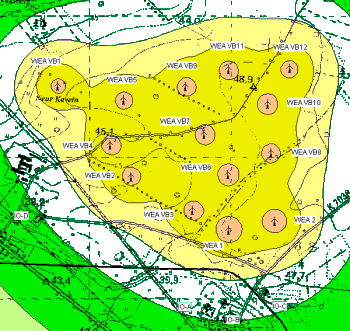Calculation of Noise Immission
Contact:
M.Eng. C. Hoffmann
M.SC R. Gradewald
Facilities that are subject to approval, e.g. wind farms and wind turbines (WT) are liable to the demands of the “Bundes-Issionsschutzgesetz (BImSchG)”. Within the scope of applications for planning and building permissions for WT, the demand arises to check the observance of duties from the § 22 BImSchG.
The inspection usually takes place on the basis of an independently carried out prognosis of immission (I-prognosis) of the evaluation level to be expected at the decisive sites of immission. The calculation of noise immission is carried out on basis of accepted technical calculation- and assessment procedures, essentially on basis of the international standard DIN ISO 9613-2 and specific national requirements.
A calculation of noise immission resistant in the results presupposes that certain minimum requirements are kept. Apart from the independence of the executing department it is indispensable to determine the input quantity within the scope of a site evaluation and therefore to be able to realistically and extensively judge the immission situation. During the site inspection the attention has to be directed to the decisive points of immission, to the orographic, structural and other conditions, especially to the already existing noise sources at the site as well as to the evaluation of the whole immission situation.
Essential input quantities for the calculation of noise immission are the acoustic characteristics of the considered system. If provided that existing noise sources at the site have to be considered, on one hand data from a licensing procedure could be used or one could fall back on known bases, but on the other hand at least orienting measurements could be carried out.
For reasons of planning security one always as to fall back on measured emission data of WT. Because of that, statements about the sound power level, its dependence on the wind speed respectively active power as well as statements about possible distinctive features of the WT sound (tonality and impulsivity, depth frequent sound) have to be available, which are based on the measuring results according to the state of art.

Result of the calculation of noise immission
Because of long-term of prototypes in some cases no or not sufficient results are available.
In these cases at least resilient assumptions have to be done, if possible on basis of at least temporary measuring results.
Statements about the directivity of the WT are usually not made, whereas this depends on the single planning case.
The input quantities, general conditions of the model and the results of the calculation of noise immission are put down in an extensive and informative test report, so that the licensing authorities are able to carry out an appropriate inspection.
